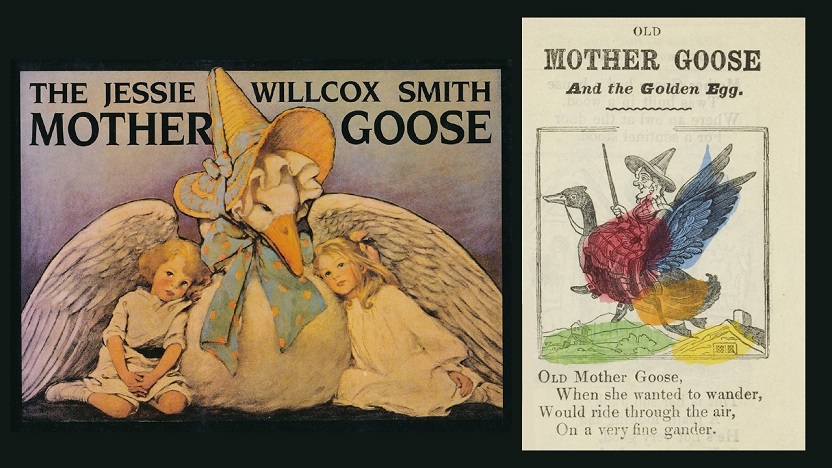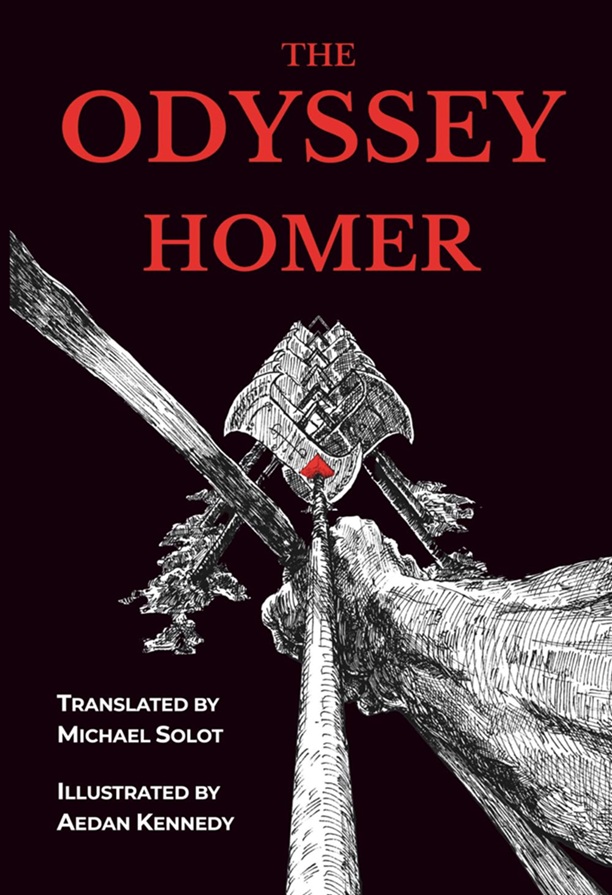.
Why Children Like Nursery Rhymes
A story to be told, a tale to tell
Of things that do not matter much at all.
Who cares about the farmer in the dell?
Or Humpty-Dumpty falling off a wall?
The pickled peppers Peter Piper Picked?
Jack Horner in the corner eating pie?
Such nursery rhymes seem written to inflict
A grownup’s mind with plots both thin and dry.
And yet most children seem to be amused
To hear them read again “just one more time!”
Which leaves the literary types bemused,
While missing the whole point of pointless rhyme.
It’s not the plot that tickles children’s hearing,
The rhythmic rhyme itself is what’s endearing.
.
.
Mother Goose
Old Mother Goose is noted for
__Her story-telling fame.
But something we should not ignore
__Is how she got her name.
The source was Charles Perrault’s patois.
__Instead of “Madam Peahen,”
He published tales by Mère l’Oye
__In sixteen-ninety-seven.
Red Riding Hood, is one he wrote
__With Puss and Boots’ debut.
With Cinderella worth a note,
__And Sleeping Beauty, too.
The stories are a tour de force,
__Infused with moral candor,
He mentions Mother Goose,” of course . . .
__But leaves out Father Gander.
__
Note: The full title is, Histoires ou Contes du Temps passé, avec des moralités—Les Contes de ma Mère l’Oye or Tales and Stories of the Past with Morals—Tales of Mother Goose.
.
.
Where Do Cats & Dogs Go
When They Die?
Where do cats go when they die?
To heaven? Hell? Or outer space?
No one really knows, but I
Am sure it is a purr-fect place.
Where do dogs go when they die?
Purr-haps to those same habitats.
There, with dripping tongues awry,
They chase, but never catch, the cats.
.
.
James A. Tweedie is a retired pastor living in Long Beach, Washington. He has written and published six novels, one collection of short stories, and three collections of poetry including Mostly Sonnets, all with Dunecrest Press. His poems have been published nationally and internationally in The Lyric, Poetry Salzburg (Austria) Review, California Quarterly, Asses of Parnassus, Lighten Up Online, Better than Starbucks, Dwell Time, Light, Deronda Review, The Road Not Taken, Fevers of the Mind, Sparks of Calliope, Dancing Poetry, WestWard Quarterly, Society of Classical Poets, and The Chained Muse. He was honored with being chosen as the winner of the 2021 SCP International Poetry Competition.















These three poems are really great, and they confirm what many persons have argued — that the best way to introduce children to poetry is via Mother Goose rhymes. They are delightful, unforgettable, and provide a child with a solid basis in the older, non-iambic pentameter rhythms.
They also do something vitally important. They show that what matters in a poem is NOT its “meaning” or “message” or “moral” (the “three miseries”), but the linguistic pleasure that is provided by sheer playfulness, and ingenuity in words, images, and strange situations. Jack Sprat, Simple Simon, Elsie Marley, “Ride a cock horse to Banbury Cross”… these are priceless treasures.
One minor point — some have argued that the original source of the Mother Goose character was the Frankish queen Bertrada of Laon, who was Charlemagne’s mother. She was called “the queen with the goose-foot,” (regina pede aucae), perhaps because of some physical deformity.
These are charming! Liked the line about Father Gander being ignored. Early Feminism?
Love these! I remember Mother Goose and Perrault’s fairy tales from as far back as I can remember. I second the idea that both need to be taught to children! The rhymes themselves in your poems are well-chosen.
Father Gander made me smile as well. Being Catholic, I imagined a gander dressed as a priest. Perhaps there could be Fr. Gander’s Catholic Nursery Rhymes?
Regarding another comment, I don’t think of noticing Father Gander being ignored as feminism; if anything, it’s anti-feminism, since feminism is all about women taking over men’s roles and having all the power, and men, especially fathers, having no more power than a slave. (Anyone who disagrees can read the Seneca Falls Declaration of Sentiments and any historical source of the lives of Elizabeth Cady Stanton and Susan B. Anthony.) Feminism has done more to destroy the family than anything else.
About Mother Goose’s male counterpart, he is alluded to in one of the nursery rhymes:
Old Mother Goose, when she wanted to wander,
Would ride through the air on a very fine gander.
Not a perfect rhyme in American English, but probably OK in Middle English.
Nice catch! I had forgotten that old couplet.
My mother read Mother Goose nursery rhymes to me when I was a child and that was my initiation into words that rhyme. That became my motivation in later life to return to the world of poems and begin writing. I have written a lot of children’s poems that I consider to have meaning, messages, and morals attached to them, but I never thought of them, nor will I ever consider them to be miseries, but rather teaching vehicles in a fun form. There is a more proximate supposition in the U.S. that the original Mother Goose was Elizabeth, the Bostonian wife of Isaac Goose. Elizabeth went to live with her eldest daughter, who had married publisher Thomas Fleet. Rumor was “her son-in-law gathered her jingles together and printed them. No evidence of such printing has been found, and historians believe this story was concocted by Fleet’s great-grandson John Fleet Eliot in 1860.” (Source: Wikipedia) In any event, the collection has so many nursery rhymes that had to have originated in England, such as “Tom, Tom, the Piper’s Son,” “London Bridge is Falling Down,” and “Humpty Dumpty,” with meaning traced back to the King of England. I enjoyed these poems, James, and am glad they were published here.
The problem is the dating. Charles Perrault’s “Contes de ma mere l’Oye” (Tales of my Mother Goose) came out in 1697, before anything like it happened in New England. Of course, if there was a real Elizabeth Goose, it may well have been a serendipitous coincidence.
I don’t say that meanings, messages, and morals are always bad in poetry. There’s a place for everything, like castor oil and enemas. But a great many nursery rhymes or stories from Mother Goose deal with cynical, unpleasant, or dicey types like Georgie Porgie, the Jolly Miller on the River Dee, the Knave of Hearts, Tom, the Piper’s Son, and a lot of other rascals. There’s mischief and troublemaking in much of that material, which is why kids love them.
It’s curious that so many of the nursery rhymes read to me had something to do with food. There’s Jack Sprat, Peter the pumpkin eater, Little Miss Moffet, the four-and-twenty blackbirds, peas porridge hot, and, I’m sure, many others.
James, a delightful trio. I read them accompanied by Ravel’s equally delightful “Mother Goose suite”
Thank you for a bit of fun today.
Your poems bring a lot of ideas into focus with regards to nursery rhymes and how they capture the child’s imagination.
You’ve left me with a lot to think about, and a fair bit of writing, perhaps.
Thanks for the reads, James.
All are delightful. I note that in the line “He mentions Mother Goose,” of course . . .” there’s no beginning quotation mark.
Oops
Delightfully fun to read these three poems James. I have heard nursery rhymes called nonsense rhymes and perhaps they are, but as children I think we all loved them. Thank you for these.